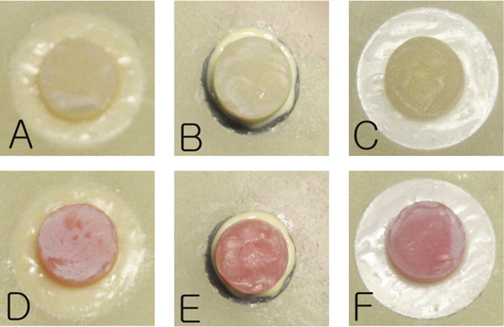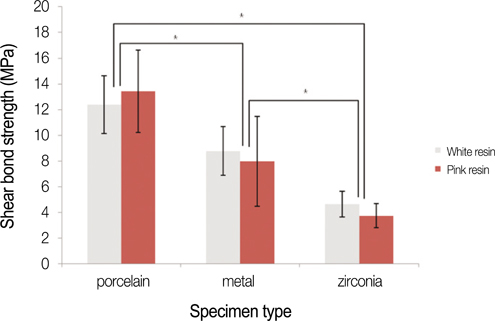J Adv Prosthodont.
2011 Sep;3(3):166-171. 10.4047/jap.2011.3.3.166.
Evaluation of shear bond strengths of gingiva-colored composite resin to porcelain, metal and zirconia substrates
- Affiliations
-
- 1Seoul Grace Dental Clinic, Seoul, Korea.
- 2Department of Prosthodontics, School of Medicine, Ewha Womans University, Seoul, Korea. prosth@ewha.ac.kr
- KMID: 2118127
- DOI: http://doi.org/10.4047/jap.2011.3.3.166
Abstract
- PURPOSE
The purpose of this study is to evaluate and compare the shear bond strength of the gingiva-colored composite resin and the tooth-colored composite resin to porcelain, metal and zirconia.
MATERIALS AND METHODS
Sixty cylindrical specimens were fabricated and divided into the following 6 groups (Group 1-W: tooth-colored composite bonded to porcelain, Group 1-P: gingiva-colored composite bonded to porcelain, Group 2-W: tooth-colored composite bonded to base metal, Group 2-P: gingiva-colored composite bonded to base metal, Group 3-W: toothcolored composite bonded to zirconia, Group 3-P: gingiva-colored composite bonded to zirconia). The shear bond strength was measured with a universal testing machine after thermocycling and the failure mode was noted. All data were analyzed using the two-way analysis of variance test and the Bonferroni post-hoc test at a significance level of 0.05.
RESULTS
The mean shear bond strength values in MPa were 12.39, 13.42, 8.78, 7.98, 4.64 and 3.74 for Group 1-W, 1-P, 2-W, 2-P, 3-W and 3-P, respectively. The difference between the two kinds of composite resin was not significant. The shear bond strength of Group 1 was the highest and that of Group 3 was the lowest. The differences among Group 1, 2 and 3 were all significant (P<.05).
CONCLUSION
The shear bond strength of the gingiva-colored composite was not less than that of the tooth-colored composite. Thus, repairing or fabricating ceramic restorations using the gingiva-colored composite resin can be regarded as a practical method. Especially, the prognosis would be fine when applied on porcelain surfaces.
MeSH Terms
Figure
Reference
-
1. Lesmes D, Laster Z. Innovations in dental implant design for current therapy. Oral Maxillofac Surg Clin North Am. 2011. 23:193–200.2. Madan N, Pannu K. Restoration of maxillary anterior esthetics using lava all-ceramic fixed dental prostheses. Int J Comput Dent. 2011. 14:47–53.3. Wall JG, Cipra DL. Alternative crown systems. Is the metal-ceramic crown always the restoration of choice? Dent Clin North Am. 1992. 36:765–782.4. Davidowitz G, Kotick PG. The use of CAD/CAM in dentistry. Dent Clin North Am. 2011. 55:559–570.5. Cosyn J, Eghbali A, De Bruyn H, Collys K, Cleymaet R, De Rouck T. Immediate single-tooth implants in the anterior maxilla: 3-year results of a case series on hard and soft tissue response and aesthetics. J Clin Periodontol. 2011. 38:746–753.6. Chow YC, Wang HL. Factors and techniques influencing peri-implant papillae. Implant Dent. 2010. 19:208–219.7. Evans CD, Chen ST. Esthetic outcomes of immediate implant placements. Clin Oral Implants Res. 2008. 19:73–80.8. Miyamoto Y, Obama T. Dental cone beam computed tomography analyses of postoperative labial bone thickness in maxillary anterior implants: comparing immediate and delayed implant placement. Int J Periodontics Restorative Dent. 2011. 31:215–225.9. Kan JY, Rungcharassaeng K, Sclar A, Lozada JL. Effects of the facial osseous defect morphology on gingival dynamics after immediate tooth replacement and guided bone regeneration: 1-year results. J Oral Maxillofac Surg. 2007. 65:13–19.10. De Rouck T, Collys K, Cosyn J. Immediate single-tooth implants in the anterior maxilla: a 1-year case cohort study on hard and soft tissue response. J Clin Periodontol. 2008. 35:649–657.11. Coachman C, Salama M, Garber D, Calamita M, Salama H, Cabral G. Prosthetic gingival reconstruction in a fixed partial restoration. Part 1: introduction to artificial gingiva as an alternative therapy. Int J Periodontics Restorative Dent. 2009. 29:471–477.12. Salama M, Coachman C, Garber D, Calamita M, Salama H, Cabral G. Prosthetic gingival reconstruction in the fixed partial restoration. Part 2: diagnosis and treatment planning. Int J Periodontics Restorative Dent. 2009. 29:573–581.13. Coachman C, Salama M, Garber D, Calamita M, Salama H, Cabral G. Prosthetic gingival reconstruction in fixed partial restorations. Part 3: laboratory procedures and maintenance. Int J Periodontics Restorative Dent. 2010. 30:19–29.14. dos Santos JG, Fonseca RG, Adabo GL, dos Santos Cruz CA. Shear bond strength of metal-ceramic repair systems. J Prosthet Dent. 2006. 96:165–173.15. Haneda IG, Fonseca RG, de Almeida JG, Cruz CA, Adabo GL. Shear bond strength of metal-ceramic repair systems. Gen Dent. 2009. 57:644–651.16. Wolf DM, Powers JM, O'Keefe KL. Bond strength of composite to porcelain treated with new porcelain repair agents. Dent Mater. 1992. 8:158–161.17. Ozcan M. Fracture reasons in ceramic-fused-to-metal restorations. J Oral Rehabil. 2003. 30:265–269.18. Ozcan M, Niedermeier W. Clinical study on the reasons for and location of failures of metal-ceramic restorations and survival of repairs. Int J Prosthodont. 2002. 15:299–302.19. Campos RE, Soares CJ, Quagliatto PS, Soares PV, de Oliveira OB Junior, Santos-Filho PC, Salazar-Marocho SM. In Vitro Study of Fracture Load and Fracture Pattern of Ceramic Crowns: A Finite Element and Fractography Analysis. J Prosthodont. 2011. 20:447–455.20. Proos KA, Swain MV, Ironside J, Steven GP. Finite element analysis studies of a metal-ceramic crown on a first premolar tooth. Int J Prosthodont. 2002. 15:521–527.21. Farah JW, Craig RG. Distribution of stresses in porcelain-fused-to-metal and porcelain jacket crowns. J Dent Res. 1975. 54:255–261.22. Oyar P, Ulusoy M, Eskitascioglu G. Finite element analysis of stress distribution of 2 different tooth preparation designs in porcelain-fused-to-metal crowns. Int J Prosthodont. 2006. 19:85–91.23. Behr M, Proff P, Kolbeck C, Langrieger S, Kunze J, Handel G, Rosentritt M. The bond strength of the resin to zirconia interface using different bonding concepts. J Mech Behav Biomed Mater. 2011. 4:2–8.24. Barreto MT, Bottaro BF. A practical approach to porcelain repair. J Prosthet Dent. 1982. 48:349–351.25. Villarroel M, Fahl N, De Sousa AM, De Oliveira OB Jr. Direct esthetic restorations based on translucency and opacity of composite resins. J Esthet Restor Dent. 2011. 23:73–87.26. Atsu SS, Kilicarslan MA, Kucukesmen HC, Aka PS. Effect of zirconium-oxide ceramic surface treatments on the bond strength to adhesive resin. J Prosthet Dent. 2006. 95:430–436.27. May LG, Passos SP, Capelli DB, Ozcan M, Bottino MA, Valandro LF. Effect of silica coating combined to a MDP-based primer on the resin bond to Y-TZP ceramic. J Biomed Mater Res B Appl Biomater. 2010. 95:69–74.28. Dias de Souza GM, Thompson VP, Braga RR. Effect of metal primers on microtensile bond strength between zirconia and resin cements. J Prosthet Dent. 2011. 105:296–303.29. Kitayama S, Nikaido T, Takahashi R, Zhu L, Ikeda M, Foxton RM, Sadr A, Tagami J. Effect of primer treatment on bonding of resin cements to zirconia ceramic. Dent Mater. 2010. 26:426–432.30. Aboushelib MN. Evaluation of zirconia/resin bond strength and interface quality using a new technique. J Adhes Dent. 2011. 13:255–260.31. Chen L, Suh BI, Kim J, Tay FR. Evaluation of silica-coating techniques for zirconia bonding. Am J Dent. 2011. 24:79–84.32. Blatz MB, Sadan A, Martin J, Lang B. In vitro evaluation of shear bond strengths of resin to densely-sintered high-purity zirconium-oxide ceramic after long-term storage and thermal cycling. J Prosthet Dent. 2004. 91:356–362.33. Leibrock A, Degenhart M, Behr M, Rosentritt M, Handel G. In vitro study of the effect of thermo- and load-cycling on the bond strength of porcelain repair systems. J Oral Rehabil. 1999. 26:130–137.
- Full Text Links
- Actions
-
Cited
- CITED
-
- Close
- Share
- Similar articles
-
- Shear bond strength of veneer ceramic and colored zirconia by using aqueous metal chloride solutions
- A study on the shear bond strengths of veneering ceramics to the colored zirconia core
- Shear bond strengths of composite resin to porcelains among porcelain repair systems
- The effect of Silano-pen on the shear bond strength of resin to feldspathic porcelain and zirconia
- A study of the shear bond strength of metal brackets and ceramic brackets and the condition after debonding




